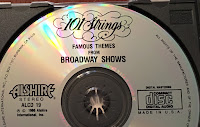This must have been a good year for music, because I easily could have made a Top 50.
These rankings don't mean much past the top 3. On any given day, I'd rank them differently. I wanted to say more about the albums, but I realized that this post would never happen if I put it off any longer.
1. Parks, Squares and Alleys – Against Illusions and Reality
A band from Moscow that has that Captured Tracks sound that Captured Tracks bands don't have anymore. It's 100% good, so check out any track.

2. Tall Tales and the Silver Lining – Tightropes
If you had told me at the beginning of the year that one of my favorite albums would come from a Tom Petty-worshipping band from L.A., I probably wouldn't have believed it. This is one of the rare albums that everyone in my household could agree on. Check out "Let It Go."
3. Petite League – Slugger

The new band by the guy from Spark Alaska. Spark Alaska made acoustic bedroom pop, but Petite League is scrappy, kinda like Cloud Nothings back when they still wrote lo-fi pop songs. Check out "Not Always Happy."
4. The Sweet Serenades – Animals

Their previous album, Help Me, was one of my faves of 2012.
5. Boyscott – Goose Bumps
Faintly Lit is delicate Japanese twee pop that got an undeserved 6.9 review in Pitchfork. The Pitchfork reviewer complained of "groan-worthy" songs and songs that "meander," and concluded that "Kato's world is ... a little too intimate for extended stays," none of which is true.
I loved the first three Ashtray Boy albums and saw the band live at a house party years ago, but I had fallen out of touch with them after their albums stopped being domestically released. This new one is just as good as any of their albums. Funny lyrics.
The second album by German dream-pop band Shoreline Is. It even has a great instrumental cut, "Till You Run Off."
A second great album from Belgium's the Future Dead on Gnar Tapes. Reminds me of the old Flying Nun sound. Really short songs.
 10. The Memories – Home Style
10. The Memories – Home Style
The prolific and dependable Memories deliver another winner. Some of these songs have appeared elsewhere, but many were new to me, including the excellent and funny "See Me Through."
I appreciate their craftsmanship. Listen to "Handsome," for example.
Reminds me a bit of fellow Brooklynites Neighbors (now defunct, sadly) but with more guitars. Sample "Cemetery Kiss."
Dreamy, minimalist pop, like Confetti or a less metronomic Young Marble Giants. Here's "Melancholia."
15. The Go! Team – The Scene Between
Acoustic Swedish pop a bit like last year's faves Featherweights but with occasionally sexually explicit lyrics, like fellow Swedes Strip Squad. This album was released on Dec. 30, 2014, so I counted it as a 2015 release. I like "The Nipple Song."
The Coneheads make me proud to be from Indiana. Their version of the Talking Heads' "Psycho Killer" really smokes. They're like Devo if Devo had been more into hardcore than New Wave and were fronted by one of the Coneheads from the SNL skit.
Odds-and-ends double album from Part Time on Burger Records. Contains one of my favorite songs of the year: "Honey Lips."
20. Giorgio Moroder – Déjà Vu
The first new album in years from the Italian bubblegum-turned-disco maestro. The poor reviews that this album received are inexplicable. The only really questionable move on the album is Britney Spears' unnecessary remake of "Tom's Diner." I was happy to see Spears on the album, but I wish she had been given a different song. The title track features Sia and went to #1 on Billboard's US dance chart. "La Disco" is cool, as is "Wildstar" (featuring Foxes).
Honorable Mentions
Justin Bieber's Purpose is surprisingly similar, in my mind, to a Heavenly Beat album. His singing is great but he needs to lose the lame raps. I liked the Legends' It's Love, which is airy and slick, like latter-day Acid House Kings. South Korea's Say Sue Me (We've Sobered Up) is worth watching. La Futur Pompiste awesomely recreated Stereolab's sound on their self-titled album. Summer Heart's Thinkin of U EP is as good as their debut, which was great. I could go on and on with runner-ups, but that's enough for now.
 Train service at the terminal ended in 1973, and the train concourse was demolished in 1974, but the fundraising efforts enabled most of the artistic mosaic panels from the structure to be moved to various locations around Cincinnati.
Train service at the terminal ended in 1973, and the train concourse was demolished in 1974, but the fundraising efforts enabled most of the artistic mosaic panels from the structure to be moved to various locations around Cincinnati.


















































